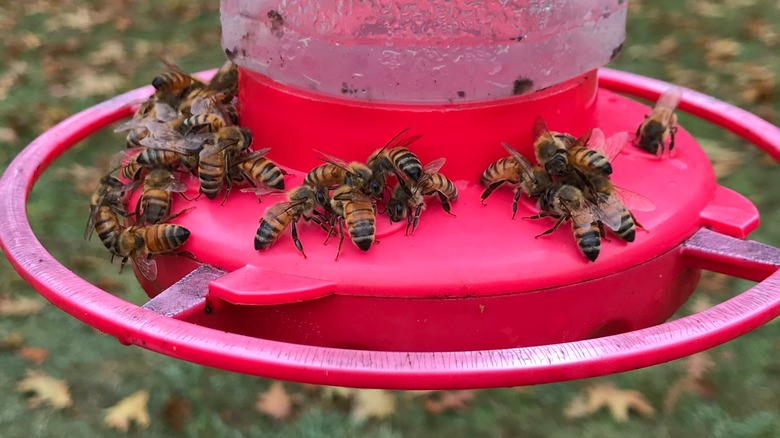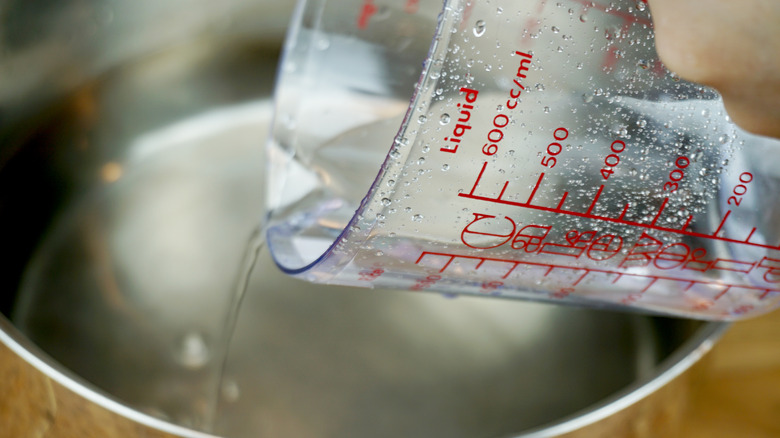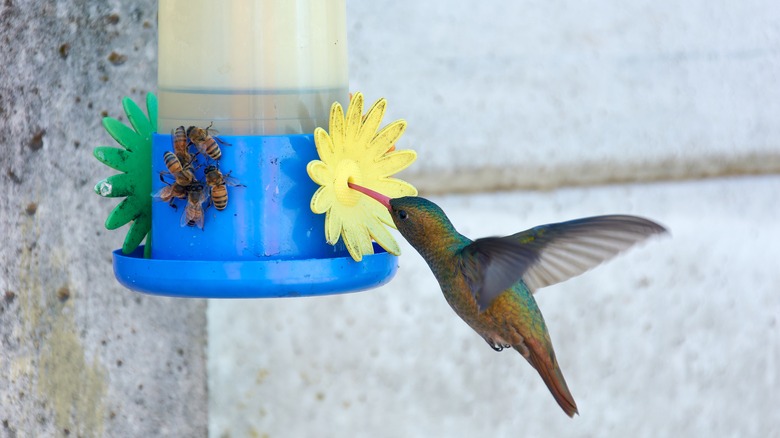Add More Of One Ingredient To Your Classic Hummingbird Nectar To Help Keep Bees Away
Hummingbird feeders are among the many ways you can attract these tiny birds to your yard and garden. Since homemade hummingbird nectar is easy to make, this is by far the most affordable method, as well as the healthiest. You only need refined white (table) sugar and water, without some of the dangerous additives you might find in commercial nectars, such as unnecessary red dyes. Even with the right tools, though, you will still face problems with hummingbird feeders from time to time, including bees. The good news is that you can reduce bees at hummingbird feeders with a slight modification to the nectar recipe: adding more water.
To make homemade hummingbird nectar, the sugar can either be dissolved in boiling water or mixed well at room temperature. If you're boiling the water, allow the nectar to cool before filling hummingbird feeders with this solution. As a general rule of thumb, hummingbird nectar requires a ratio of 1 cup of white sugar for every 4 cups of water. You can even make large batches of nectar and store the extra in your refrigerator for up to a week for easy refills. Once hummingbirds have detected homemade nectar, they will likely keep visiting the feeders you have out for them. Unfortunately, bees may also be attracted to the sugar-rich nectar. An occasional bee may not be a problem, but a swarm of the flying insects can turn into competitors for hummingbirds. If bees overtake a hummingbird feeder, chances are that hummingbirds may be less inclined to visit.
Why adding more water to nectar attracts fewer bees
Bees are attracted to nectar made from sugar water for the same reason as hummingbirds. After all, homemade nectar is similar to the nectar produced from flowers that bees might visit, so they might regard the hummingbird feeder as just another source of food for them. It's important to avoid common mistakes when making hummingbird nectar, such as putting too much sugar in the solution. But even if you follow the 1 part sugar to 4 parts water rule, it's still possible to attract bees. The key is to try to reduce the number of bees without also turning off hummingbirds.
One solution is to dilute the nectar with a bit more water. This small adjustment may be enough to no longer attract bees to the feeder without causing too many disruptions to hummingbirds. Some experts suggest using the same 1 part of sugar, but increasing the water to 5 parts instead of the typical 4 parts. This might be enough to deter bees while still ensuring hummingbirds get enough sugar.
What to do if bees are still eating your hummingbird nectar
Adding a bit more water to hummingbird nectar may help reduce the risk of a bee takeover. However, the process isn't completely foolproof, and you might find the bees to be persistent in their efforts. Consider switching to feeders that are more challenging for bees to access, including saucer-shaped versions. Bee guards are other possible solutions, but be aware that these physical exclusion methods will not block wasps.
Seeing bees at your hummingbird feeders might also indicate that there's a lack of nectar-producing flowers in the area. To that end, another possible garden solution to help keep bees away from your hummingbird feeder is to add other items to attract them. Consider planting bee-friendly flowering plants, such as bee balm (Monarda) and butterfly weed (Asclepias tuberosa), to keep these important pollinators happy. Just be sure you plant the flowers away from the hummingbird feeders so that bees won't be attracted to both. A possible last resort is to temporarily remove the feeders altogether for three to four days at a time. This should allow enough time for bees to find another food source, so you can then put your hummingbird feeders back in place.


